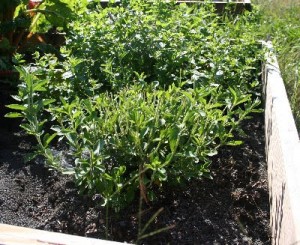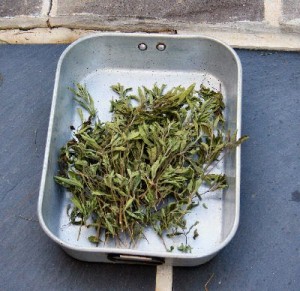Interested in learning how to grow stevia? It’s an easy to grow herb for the home garden.
Stevia Sugar Replacement Herb
I first found stevia plants through the Park Seed catalog. I bought whole plants, but now Parks seems to sell only stevia seeds. Stevia is a natural herbal sweetener. South American Indians have used it for hundreds of years as a sweetener. It appears to have no side effects and no impact on blood sugar levels, making it an ideal sweetener.
I’d been looking for a sugar replacement for years when I came across stevia I’m incredibly reactive to aspartame (Nutra Sweet). I guzzled diet colas all through high school. My diet then consisted of a slice of toast and a glass of Crystal Lite for breakfast, diet colas all day and night, and lots of other garbage I won’t even mention. Later on during college, I developed horrible stomach pains that sent me from doctor to doctor. I was told I had every disease under the sun. It wasn’t until about five years later that I made an appointment with Lynn Newman, herbalist and nutritionist.
She took one look at my diet profile and said, “I think your stomach problems are from all the aspartame you’re drinking.” Within a month of cutting it out of my diet, I was like a new woman. To this day, I know as soon as some aspartame has slipped past me – say, in a restaurant if the waiter mixes up someone’s diet cola with my regular one. Within 20 minutes I’m so sick I’m doubled over. Splenda may also be bad for you. Here is an excellent article by an medical doctor, Dr. Joseph Mercola, on why it’s best to avoid Splenda.
I don’t feel well after I drink soft drinks with Splenda in them, so I no longer use that artificial sweetener, either.
On to stevia! After researching it, I found it to be a safe alternative. It tastes fine. So when I don’t want to use real sugar, I reach for my dried stevia. But it’s expensive. So I decided to grow my own.
Where to Buy Stevia Seeds and Plants
I’ve tried to grow stevia from both seeds and plants. The seeds never germinated. From my research, other gardeners had the same problem. Most recommend plants.
You can buy stevia cuttings from the following online sources:
- The Herbal Advantage, call 800-753-9929
- Well Sweep Herb Farm, New Jersey, USA, call 908-852-5390
- Richter’s Herbs, Canada – 905-640-6677
Burpee sells stevia seeds. Perhaps you will have better luck than I did with them.
Parks now sells stevia seeds too.
How to Grow Stevia
The first step to learn how to grow stevia is to understand what it needs to thrive.

Stevia needs warmth, with soil temperatures around 50-60 degrees. Once it puts down its root system and seems happy, like mine pictured here out in the organic herb garden, it will usually winter over with some help. (I’m not taking chances; I’m taking cuttings and if they don’t root, I’m building a cold frame over it!)
Soil and Light
Stevia needs sandy loam or rich loamy soil. It also needs full sun.
I love growing herbs because they’re usually carefree, and stevia is no exception. I’ve got it growing next to the mint. It has a reputation for repelling insects, which is great for my organic garden. I have noticed that there are never any insects on it – the leaves are pristine and perfect. There are insects on the green beans directly behind it though.
Harvesting and Drying Stevia
I have been harvesting stevia throughout the growing season. I take sharp scissors and snip away the stems. I lay them in an old roasting pan. My house is full of old commercial roasting pans. Hubby’s great grandfather was a chef and I have a lot of his old equipment. It’s too big for our simple needs, but I put it to good use by recycling it for herb drying!
Most experts recommend waiting until the fall to harvest stevia. The cool temperatures intensify the sweetness. They recommend waiting as long as you can, but not letting frost nip the plants. Snip the stevia leaves and place on a rack to allow air circulation. Solar drying works fine for stevia. It takes only about a day in hot, dry weather to dry it out. Remove the leaves from the stems; crush and store. Then use as you need it.
How to Grow Stevia? It’s Simple
If you aren’t sure how to grow stevia, don’t worry.
Once you get your stevia started, it’s one of the simplest herbs to grow. My little plants struggled along for quite a while before they took off. I think the hardest part was getting them over their mail order shock. Once the warm weather came and they realized they were in a warm, sunny, rich soil, they happily sent up leaves and spread willingly.
So good luck with your stevia. It’s an organic gardener’s best friend, a great herbal sweetener, and grew well in my Virginia, zone 7 garden.
More tips on growing stevia from Stevia.





Once your stevia has grown, and you pick it, how do you use it in your cooking?
Hi Yoda Smith, thanks for leaving a comment. I haven’t used stevia in cooking yet. I do use it to sweeten things, especially herbal teas. I use it instead of sweeteners like honey. The website I linked to at the end of the article has a conversion ration when changing from using sugar to honey. Stevia has a tiny after taste, and I’ve found it gives black tea beverages a strong taste, but I like it in herbal teas. Remember that home grown stevia has varied sweetness; your own dried batches may not be as sweet as products you purchase at the store. Good luck and enjoy!